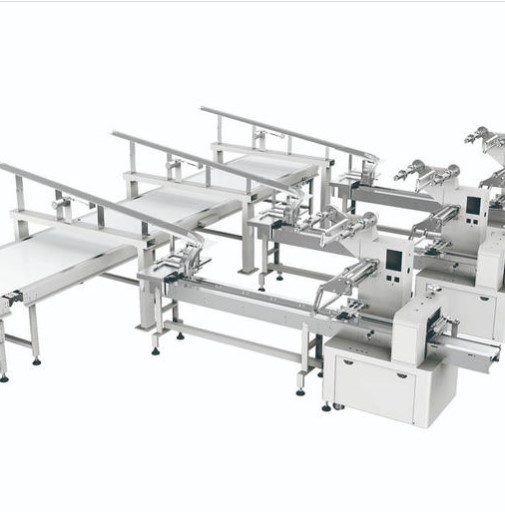ما هي عملية التغليف الآلي؟
في مشهد التصنيع الحديث سريع التطور، أصبحت الكفاءة والدقة أمرًا بالغ الأهمية. أحد الجوانب الحاسمة التي تساهم بشكل كبير في تحقيق هذه الأهداف هو عملية التغليف الآلي. لا تؤدي استراتيجية التعبئة الثورية هذه إلى زيادة الإنتاج فحسب، بل تضمن أيضًا التوحيد والدقة في المنتج النهائي. في هذه المقالة، سوف نتعمق في المكونات والفوائد الرئيسية لعملية التغليف الآلي، ونلقي الضوء على أهميتها في المشهد الصناعي اليوم.
تعريف عملية التغليف الآلي
وتستلزم عملية التغليف الآلي استخدام الآلات والتكنولوجيا الحديثة لإنجاز عمليات التعبئة والتغليف المختلفة دون مشاركة بشرية مباشرة. تشمل هذه العملية مجموعة من الأنشطة، بدءًا من التعبئة والختم وحتى وضع العلامات والنشر على منصات نقالة، ويتم تنفيذها جميعًا بسلاسة بواسطة الأنظمة الآلية. الهدف الأساسي هو تحسين خط التعبئة والتغليف، وتقليل الأخطاء البشرية، وتعزيز الكفاءة التشغيلية الشاملة.
المكونات الرئيسية للتغليف الآلي
فيما يلي بعض المكونات الرئيسية للتغليف الآلي:
أنظمة التعبئة
تعمل أنظمة التعبئة الآلية بشكل صحيح على قياس وتوزيع الكمية المطلوبة من المنتج في حاويات التعبئة. يمكن لهذه الأنظمة التعامل مع نطاق واسع من لزوجة المنتج وتماسكه، مما يضمن عمليات تعبئة دقيقة ومتسقة.
آلات الختم والإغلاق
تستخدم آلات الختم والإغلاق التكنولوجيا المتقدمة لإغلاق العبوات بشكل آمن. باستخدام الختم الحراري، أو الختم بالغراء، أو طرق أخرى، تضمن هذه الأجهزة تغليفًا محكمًا وواضحًا للتلاعب.
معدات وضع العلامات
تقوم آلات وضع العلامات الآلية بوضع الملصقات بسرعة ودقة، مما يضمن تحديد كل منتج بشكل صحيح. يمكن لهذه الأنظمة التعامل مع مجموعة متنوعة من أنواع وأحجام الملصقات، مما يؤدي إلى مظهر نظيف واحترافي.
روبوتات المنصات النقالة
في منشآت التصنيع واسعة النطاق، تتولى روبوتات المنصات النقالة مهمة ترتيب المنتجات النهائية على المنصات. تعمل روبوتات التكديس هذه على تحسين التشغيل، مما يضمن الاستقرار أثناء النقل والتخزين.
أنظمة مراقبة الجودة
غالبًا ما تشتمل خطوط التغليف الآلية على أنظمة مراقبة الجودة، مثل أجهزة الاستشعار والكاميرات، لفحص المنتجات بحثًا عن العيوب. وهذا يساهم في الحفاظ على معايير عالية ويقلل من إمكانية وصول التغليف دون المستوى المطلوب إلى العملاء.
فوائد التغليف الآلي
زيادة الكفاءة
لا تعمل الأتمتة على تسريع عملية التعبئة فحسب، بل تسمح أيضًا بالتشغيل المستمر، مما يقلل وقت التوقف عن العمل الناتج عن العمل اليدوي. والنتيجة هي ارتفاع معدلات الإنتاج، وزيادة الإنتاجية، والقدرة على تلبية متطلبات السوق المتزايدة بشكل فعال.
الاتساق والدقة
تقوم الأنظمة الآلية، بحكم تعريفها، بالوظائف بدرجة من الدقة يصعب تقليدها يدويًا. إن الاتساق والدقة التي توفرها الأتمتة تقلل من الاختلافات في جودة التغليف، مما يقلل الحاجة إلى إعادة العمل ويضمن أن كل منتج يلبي المعايير المحددة.
توفير في التكاليف
في حين أن الاستثمار الأولي في معدات التعبئة والتغليف الآلية مرتفع، إلا أن المزايا طويلة المدى تترجم إلى تخفيضات كبيرة في التكلفة. يساهم انخفاض تكاليف العمالة وانخفاض معدلات الخطأ وزيادة الكفاءة الإجمالية في تحقيق عائد إيجابي على الاستثمار بمرور الوقت.
القدرة على التكيف وقابلية التوسع
تتيح قدرة أنظمة التغليف الآلية على التكيف للمصنعين استيعاب التغييرات في أنواع المنتجات أو تنسيقات التغليف أو أحجام الإنتاج بسهولة. ونظرًا لقابلية التوسع، يمكن للمؤسسات التكيف بسرعة مع تقلبات السوق ومتطلبات العملاء المتغيرة.
خاتمة
تقف عملية التغليف الآلي بمثابة شهادة على التطور المستمر لممارسات التصنيع. باعتبارها المورد الرائد لآلات التعبئة ، فإن شركةoontrue ملتزمة بتقديم مجموعة واسعة من آلات التعبئة بما في ذلك آلات التعبئة الأوتوماتيكية ، وآلات تعبئة التغليف المتدفق ، وآلات التعبئة الأفقية ، وما إلى ذلك. إذا كنت مهتمًا بها، فلا تتردد في تصفح موقعنا على الإنترنت للمزيد تفاصيل المنتج!
الأسئلة الشائعة
س1: كيف يعمل التغليف الآلي على تحسين الكفاءة في التصنيع؟ ج: يعمل التغليف الآلي على تحسين كفاءة التصنيع من خلال تبسيط عملية التغليف بأكملها. يتم تنفيذ مهام التعبئة والختم ووضع العلامات والتحريك على منصات نقالة بدقة وسرعة، مما يقلل من وقت التوقف عن العمل ويزيد معدلات الإنتاج الإجمالية. يؤدي التنفيذ المتسق والدقيق لهذه المهام إلى تقليل الحاجة إلى التدخل اليدوي، مما يسمح للمصنعين بتلبية المتطلبات المتزايدة بكفاءة.
س2: ما هي أنواع المنتجات المناسبة للتغليف الآلي؟
ج: التغليف الآلي متعدد الاستخدامات ويمكن تكييفه مع أنواع المنتجات المختلفة عبر الصناعات. إنها مناسبة لمجموعة واسعة من السلع، بما في ذلك على سبيل المثال لا الحصر، السوائل والمساحيق والمواد الحبيبية والمنتجات الصلبة. تسمح مرونة الأنظمة الآلية للمصنعين بتعديل المعلمات لاستيعاب لزوجة المنتج المختلفة وتناسقه وتنسيقات التعبئة والتغليف.
س3: كيف تساهم أنظمة التغليف الآلية في توفير التكاليف على المدى الطويل؟
ج: في حين أن الاستثمار الأولي في أنظمة التعبئة والتغليف الآلية يمكن أن يكون كبيرًا، إلا أن الفوائد طويلة المدى تساهم في توفير كبير في التكاليف. تعمل العمليات الآلية على تقليل تكاليف العمالة عن طريق تقليل الحاجة إلى العمل اليدوي، ويؤدي انخفاض معدلات الخطأ إلى تقليل عمليات إعادة العمل والهدر. بالإضافة إلى ذلك، تؤثر الكفاءة الإجمالية المتزايدة لخط التعبئة والتغليف بشكل إيجابي على عائد الاستثمار بمرور الوقت.




